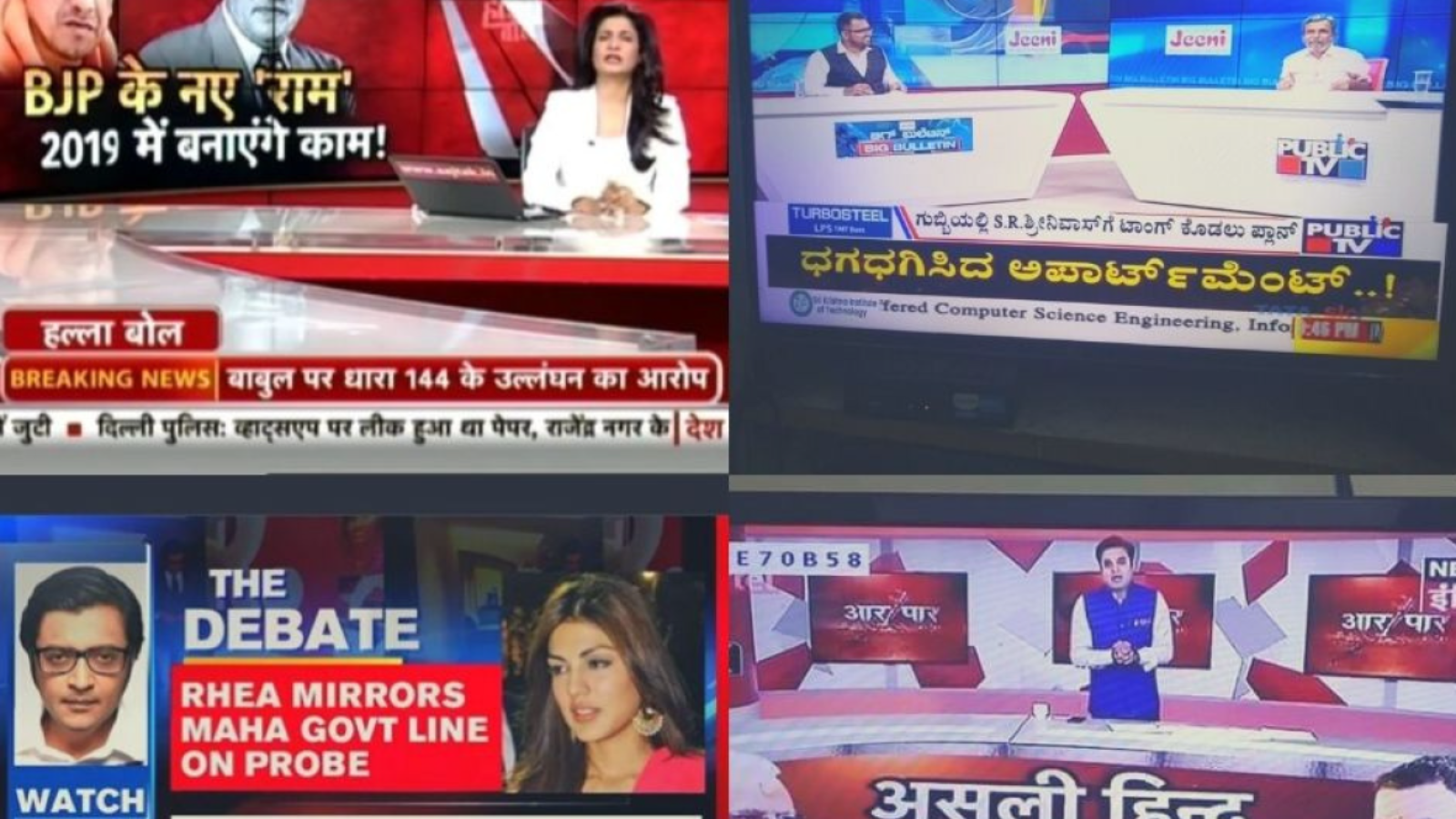How Indian TV news became a theatre of aggression fanning the flames of populism

Image from Network of Women in Media, India (NWMI) report
As the war waged on in Ukraine, Indian news channel Republic TV invited approximately a dozen guests to discuss various aspects of Russia’s invasion on Nation Wants to Know, its prime-time show.
The screen was divided into ten small boxes, with a guest peering in from each. Five boxes lined the top of the screen and five below them. On top of those boxes, “RUSSIA ADVANCES USING BELARUS” flashed periodically in bold red. At the bottom of the screen was the hashtag #WestInDenial?
At one point during the discussion, Gilbert Doctorow, one of the guests, questioned the news anchor, Arnab Goswami: “Are you allowing me to speak or am I just [here] to watch?”
It was a question that may have been on the minds of most of Goswami’s guests as he is known to hog most of the show’s time pontificating in a shrill voice. Doctorow, an author and Russia expert, went on to say, “You talk about de-escalate. So I would ask you, the moderator, to de-escalate your language. You are speaking in very hyper-tense words and you are using very emotive language. This is not suitable for an intellectual discussion.”
This kind of anger, yelling and intimidation will sound familiar to anyone who watches TV news in India. A report published this year by the Network of Women in Media, India (NWMI) pointed out that high-decibel screeching and frenetic finger-pointing was the staple of daily TV news channels in India. “While aggression was observed in more than 50% of all the news shows sampled, the number rose to 85% for talk shows,” says the report in which I also worked gathering some preliminary data.
The report is a collaboration between the Goethe-Institute and Max Mueller Bhavan, New Delhi along with the NWMI. Annotators monitored TV news for a week in September 2021 and made comments on toxic masculinity and hegemonic expression of aggression on TV news and debates.
The authors, who are journalists and journalism educators, attempt to quantify the effect of emotional performances played out on TV news as expressed through seven aspects: body language, words, tone of voice, use of visuals and graphic elements, sound effects and interpersonal dynamics.
For a brief time in the 1990s, TV/video news reporting was all about reporting from the field. With the rising costs of on-the-ground reporting, TV news in prime time has become mostly studio debates. According to TV ratings, this kind of screaming does very well with audiences. “It is the economy of spectatorship,” said Paromita Vohra, columnist and culture critic. TV news needs to be a spectacle to draw viewers. Anything on TV is about being visually striking. For instance, natural disasters are extremely TV-friendly stories. So are wars.
TV news as performance
Television came to India in 1959. But for the next 30 years few Indians owned a TV set. Those who did watched just one state-run channel which had programmes on farming and other educational shows. Things changed in 1991, when the country’s economy opened up to the world. Soon after, Rupert Murdoch bought STAR TV and began broadcasting to urban, richer Indians. The country would never be the same.
Along with radio, TV is the medium with the most penetration in India. “Despite digital gaining strength, TV news still has a strong influence on most of the population,” said Usha Raman, Professor at the Department of Communication, University of Hyderabad and one of the editors of the report. Today, there are more than 800 licensed channels, a number that includes outlets focused both on news and entertainment. According to estimates, more than 70% of India’s 1.3 billion people will have access to a television by next year. For context, only around 50% of Indians have access to the internet.
News channels compete for eye balls with entertainment channels, said a senior executive of a leading news channel who speaks on the condition of anonymity as he is not allowed to talk about internal strategy. “No one will admit this to you,” he said. “We are constantly asked why someone should watch us over dozens of competitors. We need to be able to answer that.”
The answer to that question is, more often than not, dramatic expression and aggressive language. Close to 80% of the anchors employed an aggressive tone of voice during TV debates, according to the NWMI report.
“TV has to be entertaining in order to capture an audience and sell ads,” author Sean Illing recently said while speaking to the New York Times’ Ezra Klein about his new book The Paradox of Democracy.
But why is aggression considered entertaining?
In a ditzy news studio, news anchor Deepak Chaurasia of News Nation towers over his four male guests, while they sit in a semi-circle. The high-decibel yelling creates a din, making it tough to understand anything that is being said. The bearded news anchor stands over his seated guest while shouting inaudibly and wags his finger just beside the guest’s face as if to drive a point home. “People like you [in Jawaharlal Nehru University which is considered to be left-leaning] thrive on tax payers' money but favour Pakistan,” shouts the news anchor, just inches away from the guest’s face.
An increasingly common trend
The vehemence and aggression seen in that one minute clip is common on Indian television screens.
A TV news anchor needs to sound authoritative, explained H. R. Venkatesh, a media educator and director at Boom FactCheck. Venkatesh was a familiar face on Indian TV news channels like CNN-IBN until a few years ago. “Often, while trying to sound authoritative, the anchor crosses the line,” he said.
The anchors of these debates are under pressure to elicit coherent arguments in a very limited time. Uncomplicated language, steady body language and a confident tone of voice help the anchor seem in control.
“When I watch TV news, I am most affected by the body language of the news anchor or by the words they use,” said Shaili Ramanathan, a Bangalore-based technology professional who watches at least one hour of TV news every day. “I want the anchor to quickly tell me what I need to know.”
In a way, the medium of television determines the message audiences take home – that the world is split in neat binaries and the loudest voice prevails.
Toxicity and more
At a time when India is facing multiple threats to its democratic traditions, TV news seems to be pushing India towards squarely undemocratic routes.
For instance, Sudharshan News anchor and founder Suresh Chavhanke, who is regularly known for anti-Muslim statements, gave a call to “fight, die and kill” in order to make India a Hindu nation. Chavhanke invites his viewers to take action. “So he would go out and say boycott Muslim vendors and then you would see somebody from a small town in UP or MP upload a video of them beating a poor Muslim vendor,” Supreme Court lawyer Shahrukh Alam said in a podcast.
In 2019 Newslaundry, a media-watchdog website, compiled a series of TV news debates that incited communal violence and called it Bloodlust TV.
“There is the larger problem of the structural violence they are causing which is not even prosecutable under existing IPC [Indian penal code] sections because again they are contributing very deliberately to a discourse of marginalisation,” added Alam.
As Venkatesh notes, finding angry news anchors is common. “It is easy to be angry while on air because whipping oneself into a self-righteous frenzy is not too hard. This persona is made for the TV news format and for short discussions,” he said.
This is also reflected in the report, which points out how “the aggression emanating from the newsrooms is reflected on the streets and even in homes, pushing out and silencing non-aggressive, collaborative/cooperative ways of being and interacting.”
In April this year, city municipalities in northern Indian cities of Delhi, Lucknow and Kanpur demolished shops and homes of Muslims, claiming them to be ‘illegal’. In some cases, cranes ran over the structures even after the Supreme Court of the country ordered them to stop.
Anchor Anjana Om Kashyap of Hindi news channel Aaj Tak sat in the bulldozer and said, “You are now watching live images from the crane that is going to demolish illegal construction”. Not only did the anchor not question whether the structures were legal. By riding the bulldozers, she became a visual endorsement of the government’s actions.
This is a good example of a female anchor performing aggressive behaviour for her audiences. The reason why anchors on TV behave the way they do is because they are playing with the victim-perpetrator binary, explained columnist Vohra. “Most TV programmes are about pronouncing judgement,” she said.
The report’s editor Raman agreed. “Anchors portray an intolerance to nuance, a complete discomfort with certainty,” she said.
In its current form, TV news in India is furthering the country’s shift towards majoritarianism and encouraging attacks on minorities. “[This shift] is predicated on a patriarchal articulation of the State’s strength, the suppression of dissent and the violent othering of those who are marginalised. Such attitudes are reflected and propagated in the country’s weakening institutions, and the mainstream news media is no exception,” says the report.
The only way to correct the course, according to Vohra, is to reset the terms of engagement. “Viewers should seek something more meaningful from their TV news and TV journalists should give it to them,” said Raman.
Raksha Kumar is a freelance journalist, with a specific focus on human rights. Since 2011, she has reported from 12 countries across the world for outlets such as 'The New York Times', BBC, the 'Guardian', 'TIME', 'South China Morning Post' and 'The Hindu'. Samples of her work can be found here.
In every email we send you'll find original reporting, evidence-based insights, online seminars and readings curated from 100s of sources - all in 5 minutes.
- Twice a week
- More than 20,000 people receive it
- Unsubscribe any time







